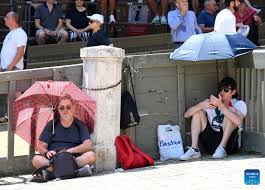Italy adapts to extreme weather as European heatwave continues

Rime: On a blistering summer afternoon in Rome, even the Colosseum’s timeless grandeur is overshadowed by the rare sight of tourists and locals huddled under umbrellas – sheltering not from the rain, but from the scorching sun.
“We used to enjoy the sun,” says Lucia, a Roman pensioner resting on a shaded bench. “Now it feels dangerous.”
This week, Italy once again finds itself at the epicenter of a growing climate emergency sweeping across Europe. A persistent and deadly heatwave has gripped much of the country, prompting red alerts in major cities, straining healthcare services, and triggering urgent conversations on long-term resilience strategies.
The heat has already taken a tragic toll. As of Wednesday, at least five people have died in Italy due to heat-related causes. A man in his 50s drowned near Turin after a river broke its banks, while a 47-year-old construction worker died of heatstroke near Bologna.
Meanwhile, on the island of Sardinia, two beachgoers died on the beach, and another person passed away in a hospital emergency room.
Hospitals are feeling the strain. According to Alessandro Riccardi, president of the Italian Society of Urgent and Emergency Medicine, emergency room visits have surged by up to 20 percent since the onset of the heatwave.
“We are seeing more illnesses in people with chronic conditions and the elderly,” Riccardi said, noting that heatwaves intensify pre-existing health problems and can cause rapid deterioration.
In Rome, authorities have deployed refreshment tents staffed by the Red Cross at tourist hotspots and transportation hubs. Pamphlets explaining heatwave safety protocols are being widely distributed, and special assistance services have been activated for the city’s vulnerable and homeless people.
Elsewhere, regional governments in Lombardy and Lazio have introduced restrictions for outdoor labor between 12:30 p.m. and 4 p.m. local time.
The searing temperatures are also testing infrastructure. In Florence and Bergamo, blackouts have been reported due to possible overloading of the power grid, driven by increased use of air conditioning. In the Veneto region, part of the freeway was temporarily closed after the asphalt cracked under the intense heat, causing traffic jams stretching 30 kilometers.





